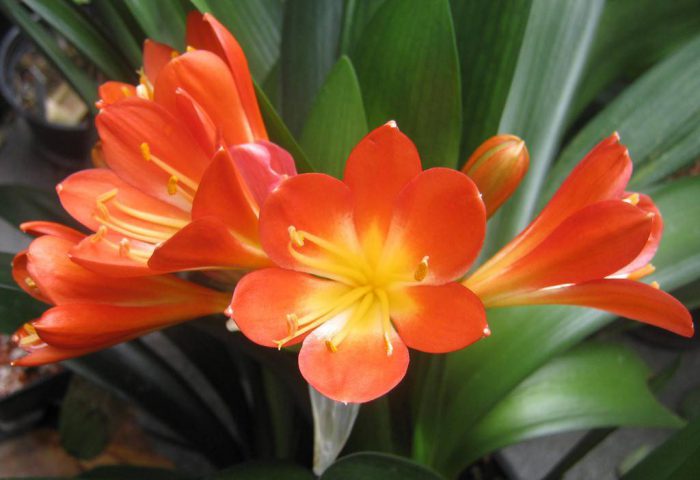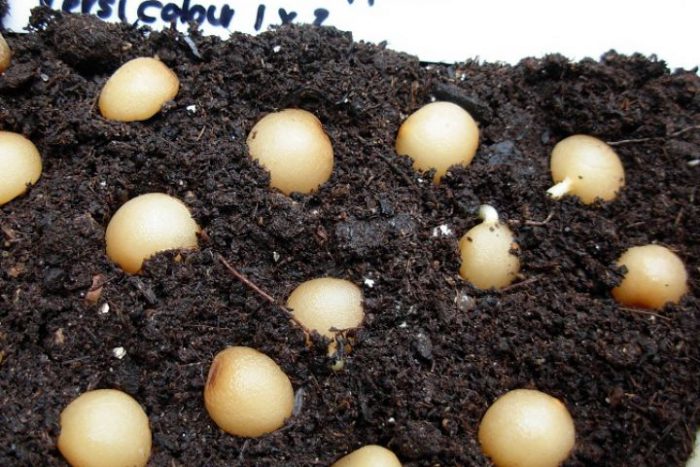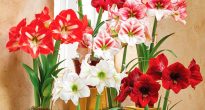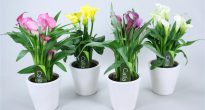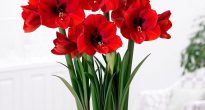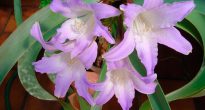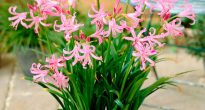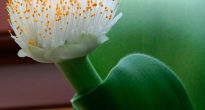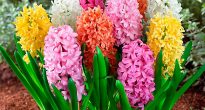A plant like Clivia (Clivia) is directly related to the Amaryllidaceae family. In the wild, it can be found in South African humid subtropical forests. This herb is perennial and has very long leaves that are collected in a rosette.
The beautiful flowers of this plant collected in inflorescences, as a rule, are colored yellow, orange or red. There are about 10–20 of these bell-shaped flowers on one inflorescence. Their blooming occurs gradually, and the flowers themselves hold on for quite a long time. Moreover, one clivia has several flower arrows.
If this flower grows indoors, then its flowering, as a rule, begins in February or March. If the clivia is large enough and well cared for, then it can bloom 2 times in 1 year.
It also has long, shiny leaves that are dark green in color. The bases of the leaves are thickened, and they are in very close contact with each other (due to this, they look like a bulb). And they are located on the rhizome. Interestingly, this plant lacks a bulb, which is a significant difference from other amaryllis. Clivia also has a fleshy and very succulent root system. It can accumulate reserves of nutrients and fluids.
This plant is quite undemanding. He does not have any special requirements for illumination or humidity. It feels best on the windowsills of windows located in the western, eastern or northern parts of the room.
As a home plant, flower growers most often choose a variety such as cinnabar clivia (Clívia miniata), it is also called the cinnabar vallota (Vallota miniata), as well as the beautiful clivia either noble (Clívia nobilis).
A variety such as cinnabar clivia has gained popularity as a medicinal plant. For the manufacture of medicinal drugs, the whole plant can be used as a whole, or rather, both the leaves and roots. Thus, the local population of Zulu, with the help of clivia rhizomes, treats fever, and also manufactures a remedy that can significantly reduce pain from a poisonous snake bite.
However, when treating the rhizome of cinnabar clivia, special care must be taken. The fact is that it contains some alkaloids, which makes it very toxic. Therefore, without special knowledge, it is better not to self-medicate.
Content
Home care for clivia
It is quite simple to care for the clivia, the main thing is to remember that it is necessary to disturb it only as a last resort. So, it is not recommended to rearrange it, loosen it, replant it, polish it, and also cut it off.
Illumination
This plant reacts extremely negatively to direct rays of the sun, therefore it needs to be shaded from them. It feels great on window sills located in the east or west of the room. It can also be placed on the northern windowsill, but it is worth considering that the growth of clivia there will slow down and, most likely, it will not bloom at all. In the warm season, it is recommended to move the flower outside and choose partial shade for its placement.
Temperature regime
This flower does very well at normal room temperature. During the growing season, it is best to provide the plant with a temperature in the range of 20-25 degrees. During the dormant period, which begins in October, the air temperature in the room should be reduced to 12-14 degrees. After the clivia has a peduncle, it is placed in a room with an air temperature of 18-20 degrees.
Humidity
This flower does not have special requirements for air humidity.
How to water
Water this plant sparingly, while making sure that no water accumulates in the pan. During the dormant period, the flower is not watered at all, or they do it extremely rarely. After the buds begin to form on the peduncle, the clivia begins to be watered abundantly and exceptionally warm water is used for this.
Top dressing
It is necessary to feed the plant only during its flowering, as well as active growth. So, during flowering, fertilizer should be applied to the soil 2 times a month. In this case, fertilizers are selected that contain a small amount of nitrogen. This is because nitrogen can cause no second flowering, but foliage will grow very well.
Features of the rest period
Clivia definitely needs to provide a dormant period, because this is the key to regular and very good flowering. As a rule, it begins in October or November. The duration of this period is 2–3 months. In order for the plant to go into a dormant period, it must not only be placed in a cool room in the autumn, but also significantly reduce watering.
Fertilizers cannot be applied to the ground at this time. The recommended temperature in the room containing clivia is 10-12 degrees. However, if this is not possible, then at ordinary room temperature the rest period proceeds quite well. In the event that the plant begins to throw off the leaves, it needs to be watered urgently (quite a bit).
Flowering features
While the plant is young, it blooms only once a year. After the flower becomes an adult, it will bloom twice a year (but this is if it is completely healthy). At the end of the dormant period, a flower arrow forms at the clivia, and after it reaches a height of 10-15 centimeters, the flower is moved to a room with normal room temperature and provided with abundant watering. It is not recommended to touch this plant until the flower arrow has fully grown, at this time it is only allowed to water it (infrequently and a little). It should be borne in mind that a sharp change in temperature can provoke a stop in the development of buds. In the case when the flower was at room temperature during the dormant period, he just needs to increase watering. At the same time, you need to water the plant with warm water in order to activate the growth of the peduncle. It is forbidden to move the flower pot during the budding and flowering period.
When the flowering is over, do not stop watering and fertilizing the flower. In the last summer months, flowering may return. In the case when the peduncle does not appear, the plant can be provided with an artificial rest period.To do this, it is rearranged in a dark and cool place, not fed, and watering is extremely rare. After a few weeks, you will be able to see that the clivia has developed a peduncle.
It is worth knowing that flowering can occur without a dormant period, and that's all, because this plant is extremely unpretentious. It is capable of adapting to almost any conditions, and at least once a year the clivia will bloom. It is noteworthy that flowering occurs each time at a different time.
You can get seeds from a plant, but artificial pollination is used. Green fruits take on a red-orange hue only after a year. In this case, you need to know that during fruiting, the plant must be regularly fed. The seeds can only be harvested after the fruits are soft.
Earth mix
For this plant, a soil mixture consisting of leafy and turfy soil, as well as sand, taken in a 2: 2: 1 ratio, is suitable. You can also mix humus, turf and peat soil, taken in a 1: 2: 1 ratio, and add a little sand. Don't forget good drainage.
How to transplant
The transplant is carried out only when absolutely necessary, for example, when the roots cease to fit in the pot. It is better to limit yourself to transshipment in order to protect the roots from damage that can lead to decay of the root system, especially if the soil is too moist. The pot must be taken a little larger than the previous one.
How to propagate
Propagated by lateral children and seeds. Lateral children are disconnected from the adult flower during transplantation, while they must have at least four leaves. For planting, use small pots filled with a mixture of sand and leafy soil. Water moderately. Flowering will come in 2 or 3 years.
Seeds are sown shortly after they ripen. For sowing, a mixture of sand and turf soil is used. Seedlings will appear in 1–1.5 months. The transplant is carried out after the appearance of 1 leaf. Growth is very slow, and such clivia will bloom only after 3 or 4 years.
Pests
Can settle mealybug or a shield. To destroy them, wipe the plant with a sponge soaked in soapy water and treat with actellik solution.
Possible problems
- Short peduncle - low air humidity or too cold.
- The leaves are very pale - lack of nutrients. Feed the flower.
- Peduncle growth has stopped - most likely, a prolonged rest period. Water the plant more often with warm water (temperature no higher than 40 degrees).
- The appearance of reddish or white spots on foliage - sunburns. Move to a shaded area.
- Flowering does not come - lack of light or high air temperature. Give the plant a full dormant period.





